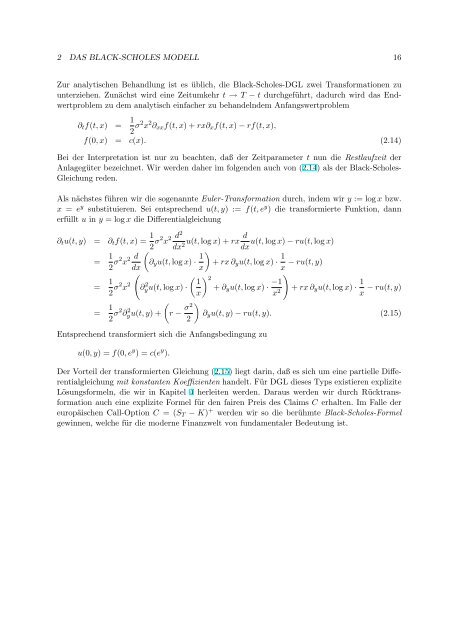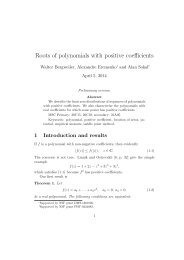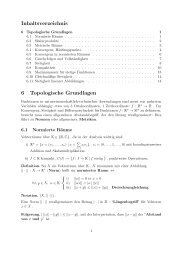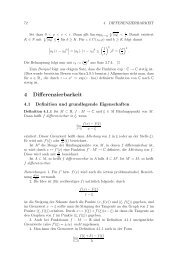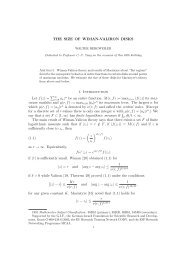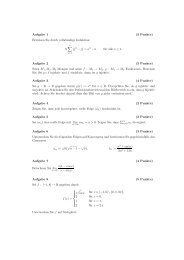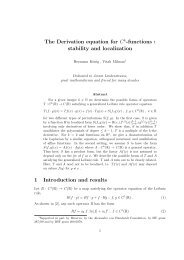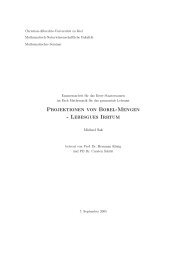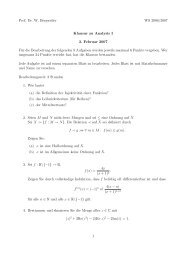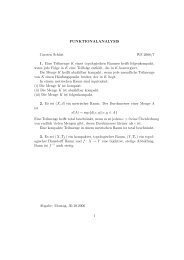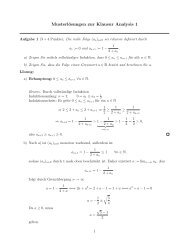Partielle Differentialgleichungen in der Finanzmathematik Vorlesung ...
Partielle Differentialgleichungen in der Finanzmathematik Vorlesung ...
Partielle Differentialgleichungen in der Finanzmathematik Vorlesung ...
Sie wollen auch ein ePaper? Erhöhen Sie die Reichweite Ihrer Titel.
YUMPU macht aus Druck-PDFs automatisch weboptimierte ePaper, die Google liebt.
2 DAS BLACK-SCHOLES MODELL 16Zur analytischen Behandlung ist es üblich, die Black-Scholes-DGL zwei Transformationen zuunterziehen. Zunächst wird e<strong>in</strong>e Zeitumkehr t → T − t durchgeführt, dadurch wird das Endwertproblemzu dem analytisch e<strong>in</strong>facher zu behandelndem Anfangswertproblem∂ t f(t, x) = 1 2 σ2 x 2 ∂ xx f(t, x) + rx∂ x f(t, x) − rf(t, x),f(0, x) = c(x). (2.14)Bei <strong>der</strong> Interpretation ist nur zu beachten, daß <strong>der</strong> Zeitparameter t nun die Restlaufzeit <strong>der</strong>Anlagegüter bezeichnet. Wir werden daher im folgenden auch von (2.14) als <strong>der</strong> Black-Scholes-Gleichung reden.Als nächstes führen wir die sogenannte Euler-Transformation durch, <strong>in</strong>dem wir y := log x bzw.x = e y substituieren. Sei entsprechend u(t, y) := f(t, e y ) die transformierte Funktion, dannerfüllt u <strong>in</strong> y = log x die Differentialgleichung∂ t u(t, y) = ∂ t f(t, x) = 1 2 σ2 x 2 d2du(t, log x) + rx u(t, log x) − ru(t, log x)dx2 dx= 1 2 σ2 x 2 d (∂ y u(t, log x) · 1 )+ rx ∂ y u(t, log x) · 1 − ru(t, y)dxxx= 1 ( 12 σ2 x(∂ 2 yu(t, 2 log x) ·x= 1 2 σ2 ∂ 2 yu(t, y) +Entsprechend transformiert sich die Anfangsbed<strong>in</strong>gung zuu(0, y) = f(0, e y ) = c(e y ).) )2+ ∂ y u(t, log x) · −1x 2 + rx ∂ y u(t, log x) · 1 − ru(t, y)x) (r − σ2∂ y u(t, y) − ru(t, y). (2.15)2Der Vorteil <strong>der</strong> transformierten Gleichung (2.15) liegt dar<strong>in</strong>, daß es sich um e<strong>in</strong>e partielle Differentialgleichungmit konstanten Koeffizienten handelt. Für DGL dieses Typs existieren expliziteLösungsformeln, die wir <strong>in</strong> Kapitel 4 herleiten werden. Daraus werden wir durch Rücktransformationauch e<strong>in</strong>e explizite Formel für den fairen Preis des Claims C erhalten. Im Falle <strong>der</strong>europäischen Call-Option C = (S T − K) + werden wir so die berühmte Black-Scholes-Formelgew<strong>in</strong>nen, welche für die mo<strong>der</strong>ne F<strong>in</strong>anzwelt von fundamentaler Bedeutung ist.


